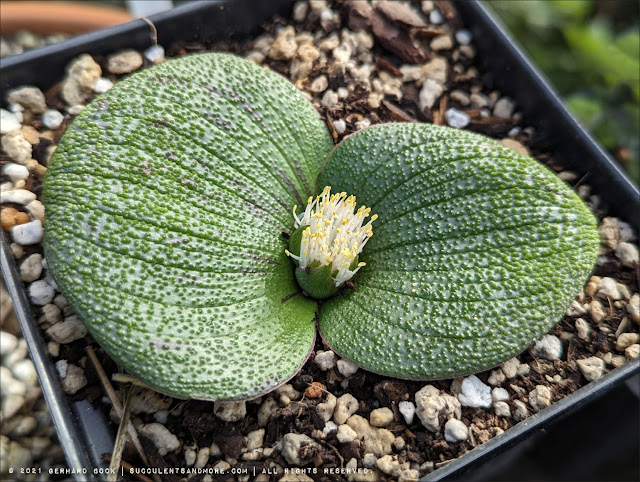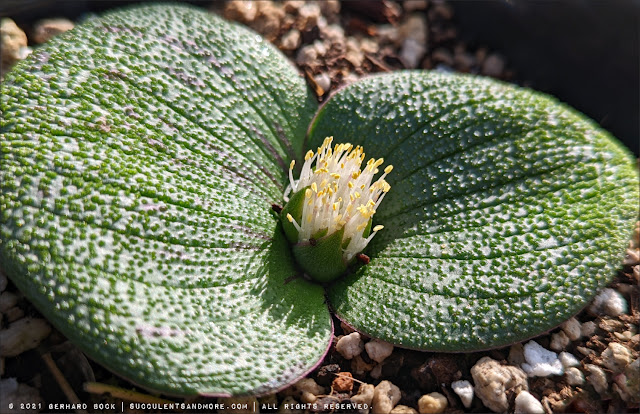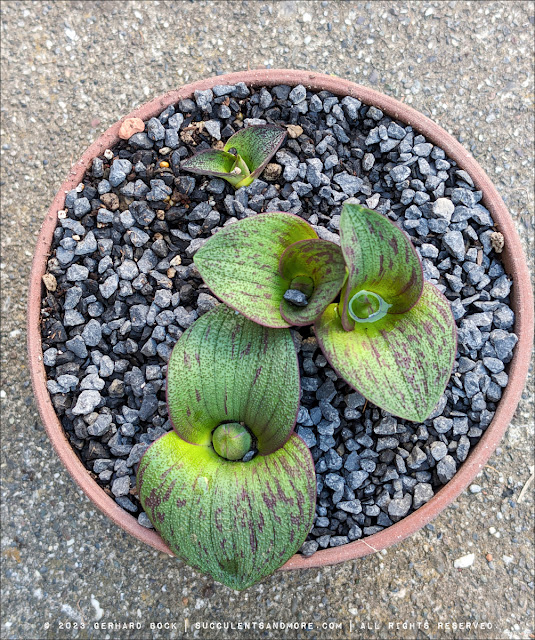The Cape Floristic Region at the southern tip of South Africa is home to an astonishing diversity of plant life, including nearly 1200 species of bulbs. We’re all familiar with amaryllis, freesia, gladiolus, crocosmia, chasmanthe, watsonia, and sparaxis, to name just a few. But there are many others that are just as beautiful albeit much less common in cultivation. Some, like lachenalia and ferraria, are becoming more available (check Annie’s Annuals’ bulb selection, for example). Others are largely relegated to the realm of collectors, who are more likely to call them “geophytes” instead of “bulbs.”
I’m not a collector, but I do pick up interesting bulbs when I see them for sale. One of them is Massonia pustulata. I have two; one I bought at the UC Berkeley Botanical Garden a few years ago, and the other at the San Diego Cactus and Succulent Society winter sale in February 2022. The larger of the two flowered last December:
 |
| Massonia pustulata, December 2022 |
The flower emerges from between the two leaves and resembles the head of a shaving brush:
The species name, pustulata, means blistered. It’s fitting, seeing how the leaves have small, raised bumps that look like pimples or, well, pustules. In spite of the name, they’re quite pleasing to the touch.
As you can see in the photos above, there was only one plant in the pot last December. The leaves disappeared in late spring, and the pot appeared empty over the summer into fall. Now look what we have this year: three plants!
 |
| Massonia pustulata, November 2023 |
I like Massonia pustulata, but I’m afraid it might get lost if I planted it out in the garden – it’s simply too small. That’s why I decided to put it in a nicer container, together with the other Massonia pustulata I got in San Diego. I’ll display the pot in a prominent spot where I can follow their progress up to flowering and beyond.
As I alluded to earlier, Massonia pustulata is a winter grower and goes dormant in the summer. In other words, its growth cycle matches the rainfall pattern in our Mediterranean climate. I leave my Massonia pustulata exposed to the elements all year. In the winter, they get whatever rain there is, and in the summer, they stay completely dry.
In Massonia pustulata‘s native habitat, nighttime temperatures do drop below freezing for short periods of time, but if you live in a harsher climate – anything below zone 9 – I’d keep it in a greenhouse or another spot where it’s protected from the cold.
I do have other South African bulbs planted out in the garden. I’ll share photos as they begin to bloom.
© Gerhard Bock, 2023. All rights reserved. To receive all new posts by email, please subscribe here.







Very interesting plants, Gerhard. They're nothing I've ever seen before or even heard of. Thanks for the introduction!
ReplyDeleteKeep an eye out for massonia or similar bulbs. I think you'd like them.
DeleteLovely. Very deserving of the new pot they now call home.
ReplyDeleteChavli
Thank you! I'll post photos of the flowers when the time comes.
DeleteAnd I've been babying mine by keeping it inside! I'm so glad you shared this, I'll definitely move it outside (in a pot) come springtime.
ReplyDeleteMine were outside all winter last winter.
DeleteIt's so nice to see those bulbs! With clear and beautiful photos and a great description. I have sown seeds of m. depressa and m.echinata this spring and had quiet a good germination rate. They are tiny but the bulbs are getting bigger. It was my first attempt as seeds also. Made me intrested in seeds overall and my latest pursuit of streptocarpus dunii was also successful. I'm really greatful for this post and am sorry for my English (I'm from Poland), but hope it is understandable.
ReplyDeleteThank you so much for your comment! Your English is perfectly understandable. I collected seeds from my Massonia pustulata last winter and gave them to friends--I have to check to see if they germinated.
DeleteSouth Africa has the coolest geophytes, all shapes and sizes. Agree with you that the Massonia would be lost in the garden as it looks pretty low. It looks great in it's pot. I actually prefer the leaves to the flower but exciting no matter when something unusual flowers. I grew Valthemia bracteata from seed obtained from Chilterns in England a few years back. They rarely flower but the bulbs are now huge. It has the coolest waved strappy foliage. Would probably do well in your climate.
ReplyDeleteImpressive.
ReplyDelete